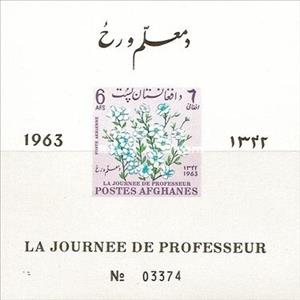Souvenir Sheet: Flax (Linum usitatissimum) (Afghanistan 1964)
Flax (Linum usitatissimum) (Afghanistan 1964)
03 March (Afghanistan ) within release Teacher's Day goes into circulation Souvenir Sheet Flax (Linum usitatissimum) face value 6 Afghan afghani
| Souvenir Sheet Flax (Linum usitatissimum) in catalogues | |
|---|---|
| Michel: | Mi: AF BL52B |
Souvenir Sheet is square format.
Also in the issue Teacher's Day:
- Stamp - Tulips face value 2;
- Stamp - Tulips face value 3;
- Stamp - Flax face value 5;
- Stamp - Iris face value 10;
- Stamp - Tulips face value 3;
- Souvenir Sheet - Tulips face value 4;
- Souvenir Sheet - Flax face value 6;
- Stamp - Flax face value 3.50;
- Stamp - Tulips face value 4;
- Stamp - Flax face value 4;
- Stamp - Iris face value 2;
- Stamp - Iris face value 1.50;
- Stamp - Flax face value 6;
- Stamp - Iris face value 2;
- Stamp - Flax face value 5;
- Stamp - Iris face value 1.50;
- Stamp - Tulips face value 2;
- Stamp - Tulips face value 3;
- Stamp - Flax face value 4;
- Stamp - Iris face value 10;
- Souvenir Sheet - Flax (Linum usitatissimum) face value 6;
Souvenir Sheet Flax (Linum usitatissimum) it reflects the thematic directions:
A flower, sometimes known as a bloom or blossom, is the reproductive structure found in plants that are floral (plants of the division Magnoliophyta, also called angiosperms). The biological function of a flower is to effect reproduction, usually by providing a mechanism for the union of sperm with eggs. Flowers may facilitate outcrossing (fusion of sperm and eggs from different individuals in a population) or allow selfing (fusion of sperm and egg from the same flower). Some flowers produce diaspores without fertilization (parthenocarpy). Flowers contain sporangia and are the site where gametophytes develop. Many flowers have evolved to be attractive to animals, so as to cause them to be vectors for the transfer of pollen. After fertilization, the ovary of the flower develops into fruit containing seeds. In addition to facilitating the reproduction of flowering plants, flowers have long been admired and used by humans to beautify their environment, and also as objects of romance, ritual, religion, medicine and as a source of food.
Flora is the plant life occurring in a particular region or time, generally the naturally occurring or indigenous—native plant life. The corresponding term for animal life is fauna. Flora, fauna and other forms of life such as fungi are collectively referred to as biota. Sometimes bacteria and fungi are also referred to as flora, as in the terms gut flora or skin flora.


